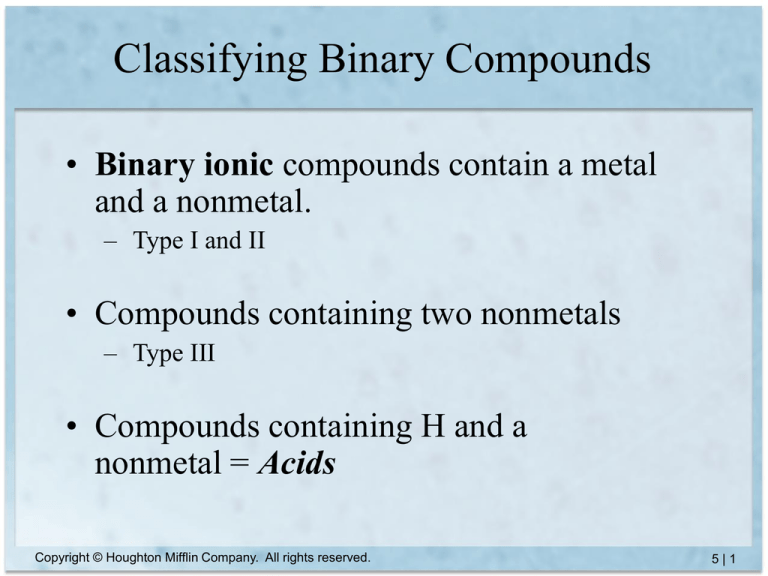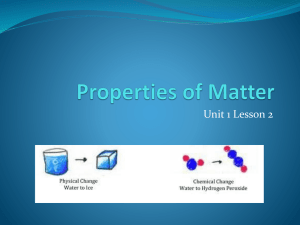
Classifying Binary Compounds
• Binary ionic compounds contain a metal
and a nonmetal.
– Type I and II
• Compounds containing two nonmetals
– Type III
• Compounds containing H and a
nonmetal = Acids
Copyright © Houghton Mifflin Company. All rights reserved.
5|1
Metal Cations
• Type I
– Metals that can only have one possible charge
– Charge determined by position on the Periodic
Table (group 1A: +1; group 2A: +2)
• Type II
– Metals that can have more than one possible
charge (transition metals)
– Metal cation’s charge (usually +1, +2, +3, or
+4) determined from the charge on anion
Copyright © Houghton Mifflin Company. All rights reserved.
5|2
The Modern Periodic Table
Copyright © Houghton Mifflin Company. All rights reserved.
5|3
Type I Binary Ionic Compounds
• Contain Metal Cation from Groups 1A, 2A or Al, Ga,
& In (metals with only one possible ionic charge) +
Nonmetal Anion
• Metal listed first in formula & name
• Name metal cation first, name nonmetal
anion second
• Nonmetal anion named by changing the ending on
the nonmetal name to –ide
Copyright © Houghton Mifflin Company. All rights reserved.
5|4
Name the following Type I Compounds:
You must know the simple cations and anions in
Table 5.1
• MgCl2
• K2O
• CaBr2
• BaS
Copyright © Houghton Mifflin Company. All rights reserved.
5|5
Type II Binary Ionic Compounds
• Metal cation name is the metal name followed
by a Roman numeral in parentheses to
indicate its charge
– Determine charge from anion charge
– Common Type II cations in Table 5.2
• Nonmetal anion named by changing the
ending on the nonmetal name to -ide
Copyright © Houghton Mifflin Company. All rights reserved.
5|6
Determining the
Charge on a Cation – Au2S3
• Determine the charge on the anion
– Au2S3: the anion is S, since it is in Group 6A, and its
charge is –2
• Determine the total negative charge
– Since there are 3 S in the formula, the total negative
charge is –6
• Determine the total positive charge
– Since the total negative charge is -6, the total positive
charge is +6
• Divide by the number of cations
– Since there are 2 Au in the formula & the total positive
charge is +6, each Au has a +3 charge
Copyright © Houghton Mifflin Company. All rights reserved.
5|7
Name the following Type II compounds:
•
•
•
•
•
CrCl3
CrCl2
Cu2O
CuO
Fe2S3
Copyright © Houghton Mifflin Company. All rights reserved.
5|8
Type III - Binary
Compounds of Two Nonmetals
• Name first element in formula first. Use the full
name of the element.
• Name the second element in the formula as if it
were an anion.
– However, remember these compounds do not
contain ions!
• Use a prefix in front of each name to indicate the
number of atoms.
• Never use the prefix mono- on the first element.
Copyright © Houghton Mifflin Company. All rights reserved.
5|9
Prefixes
Subscript
1
Prefix
mono- (not used on first nonmetal)
2
3
4
5
6
7
8
ditritetrapentahexaheptaocta-
• Drop last “a” in the prefix if the name begins with vowel: N2O5 dinitrogen
pentoxide (not pentaoxide)
Copyright © Houghton Mifflin Company. All rights reserved.
5 | 10
Name the following Type III compounds:
•
•
•
•
•
CCl4
N2O3
PCl3
PCl5
CO
Copyright © Houghton Mifflin Company. All rights reserved.
5 | 11
Roadmap for
Naming Binary Compounds
Copyright © Houghton Mifflin Company. All rights reserved.
5 | 12
Classify and name the following binary compounds:
•
•
•
•
OCl2
CaBr2
CuS
B2O3
Copyright © Houghton Mifflin Company. All rights reserved.
5 | 13
Compounds Containing
Polyatomic Ions
• Polyatomic ions are charged entities that
contain more than one atom (e.g. HSO4-)
– Must memorize name, formula, and charge
– Table 5.4
• Polyatomic compounds contain one or more
polyatomic ions.
• To name these compounds you must learn
to recognize the polyatomic ions.
(NH4C2H3O2) ammonium acetate
Copyright © Houghton Mifflin Company. All rights reserved.
5 | 14
Compounds Containing
Polyatomic Ions (cont.)
• Name polyatomic compounds by naming
cation and anion.
– Non-polyatomic ions named like Type I and II
Na2SO4 sodium sulfate
• Polyatomic acids contain H+ and a
polyatomic anion.
Copyright © Houghton Mifflin Company. All rights reserved.
5 | 15
Names of Common Polyatomic Ions
Copyright © Houghton Mifflin Company. All rights reserved.
5 | 16
Oxyanions
• -ate ion
– chlorate = ClO3-
• -ate ion plus 1 O same charge, per- prefix
– perchlorate = ClO4-
• -ate ion minus 1 O same charge, -ite suffix
– chlorite = ClO2-
• -ate ion minus 2 O same charge, hypoprefix, -ite suffix
– hypochlorite = ClO-
Copyright © Houghton Mifflin Company. All rights reserved.
5 | 17
Patterns for Polyatomic Ions
• Elements in the same column on the periodic
table form similar polyatomic ions.
– Same number of O’s and same charge
ClO3- = chlorate BrO3- = bromate
• If the polyatomic ion starts with H, add
hydrogen- before the ion’s name and add one
to the charge.
CO32- = carbonate HCO3- = hydrogen carbonate
Copyright © Houghton Mifflin Company. All rights reserved.
5 | 18
Name the following compounds:
•
•
•
•
Na3PO4
FeCO3
(NH4)2CO3
Ca(CN)2
Copyright © Houghton Mifflin Company. All rights reserved.
5 | 19
Naming Acids
• Formulas always begin with H as first element
• Can be thought of as consisting of H+ cation and
anion
• Binary acids have H+ cation and a nonmetal anion
• Oxyacids have H+ cation and a polyatomic anion
Copyright © Houghton Mifflin Company. All rights reserved.
5 | 20
Naming Acids (cont)
• If the anion does not contain oxygen, use the prefix hydroplus the suffix –ic attached to the root name of the element
followed by the word acid.
• HBr:
• When the anion contains oxygen, use the root name of the
central element of the anion, with a suffix –ic or –ous,
followed by the word acid. When the anion name ends in -ate,
the suffix –ic is used. When it ends in –ite, the suffix –ous is
used.
• H2SO4:
• H2SO3:
• HNO3:
• HNO2:
Copyright © Houghton Mifflin Company. All rights reserved.
5 | 21
Naming Acids (Summary)
Copyright © Houghton Mifflin Company. All rights reserved.
5 | 22
Writing Formulas from Names
• For Type I, Type II, polyatomic compounds and
acids:
– Determine the ions present.
– Determine the charges on the cation and anion.
– Balance the charges to get the subscripts.
• For Type III compounds, use the prefixes to
determine the subscripts.
Copyright © Houghton Mifflin Company. All rights reserved.
5 | 23
Write the formula for each of the following compounds:
•
•
•
•
diboron trioxide
copper(III) bromide
chromium (II) permanganate
phosphorus tribromide
Copyright © Houghton Mifflin Company. All rights reserved.
5 | 24








